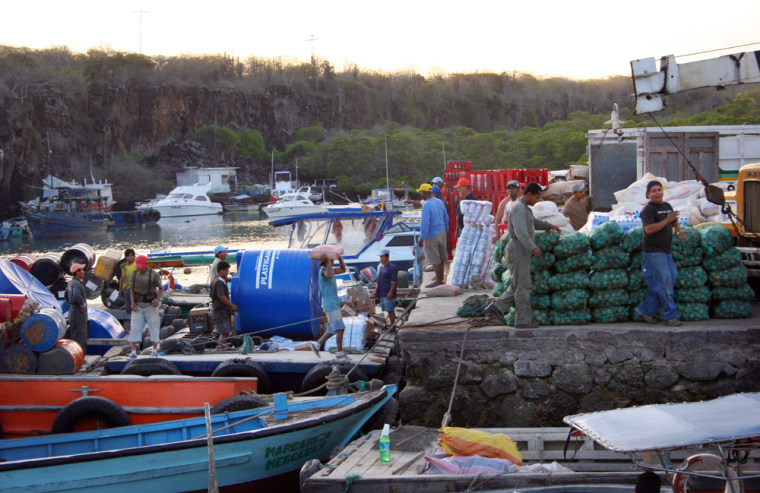An unremarkable day on the archipelago. A taxi honks at a meandering pedestrian. Shirtless men play dominoes by the market, shooing away fearless seagulls that vie for fish scraps. Dockworkers empty another cargo boat, while sunburned tourists listen to their guides explain how the unique fauna here inspired Charles Darwin to develop his theory of evolution.
Domingo Navarrete has observed scenes like this in the Galapagos Islands for 38 years -- long enough for him to develop a theory of his own.
His theory explains how the permanent population here jumped from about 2,000 in the 1960s to about 3,000 in the early 1980s, then exploded in recent years toward the estimated 30,000 that has conservationists and local officials scrambling for stricter migration controls. His explanation of change has nothing to do with natural selection, but it's so beautifully simple that he can outline it without words, just by rubbing his thumb and index finger together.
Money.
The animals -- giant tortoises, iguanas, finches, blue-footed boobies -- bring in the tourists. The tourists bring in the dollars. The dollars bring in the workers from the mainland, where money is a lot harder to find. The workers naturally want to provide for their families, so they bring them in. The islands evolve very quickly.
"It's a lot easier to live here than it is on the mainland," said Navarrete, 71, who was elected mayor twice in the 1970s. "The pay is better, so everyone wants to come here to work. But we need to control it, because we just don't have the resources to handle this kind of invasion."
The islands belong to Ecuador, a country that loses hundreds of thousands of residents each year to emigration. In the past five years, officials estimate, more than 10 percent of the country's population has left in search of better economic opportunities, mostly in the United States or Spain. But the islands, which sit about 600 miles off Ecuador's coast, are a much closer option.
With so many tourists -- more than 100,000 per year pass through -- it can be a challenge to figure out who's permanent and who's not. Some people are here on a temporary basis but are trying to stay for good.
‘I had dollar signs in my eyes’
Erika Rosero, 27, said she used to work for a flower exporter in Quito, the capital, but came to the Galapagos when she was tempted by an advertisement from a nightclub looking for someone to work the bar.
"I had dollar signs in my eyes," Rosero said. She now is looking for a way around a law imposing a three-month limit on work by nonresidents, planning to return to the mainland in the next couple of weeks, then return for good. She hopes to get another job, earn resident status, then eventually become a tour guide. The nightclub, she said, was a steppingstone to something more permanent.
"People find ways to stay all the time, no matter what the law is," said Elena Lopez, a native Galapagos Islander who operates a souvenir stand catering to tourists.
Local officials acknowledge that enforcement of the rules is problematic, but a special government census, which collected its data last week, is one of several ways they're trying to get a better handle on growth. About three months ago, officials also began issuing residents mandatory identity cards that feature photos, invisible ultraviolet ink, a computer bar code and a holographic overlay.
Some of the money for that project came from the World Wildlife Fund, which has made human migration control a key component of its conservation efforts on the island. Lauren Spurrier, managing director of the fund's Galapagos program, said the population increase is directly linked to an increase in tourism.
No end in sight to tourism growth
Though officials in 1998 limited the number of tour boats allowed in the waters around the islands to about 90 licensed craft, tour companies have decreased the average length of tours, allowing more tourists to visit. Meanwhile, the tourism industry has hired more people to keep up with the demand, Spurrier said.
"Tourist numbers have jumped from 40,000 a year to 110,000, and there's no end in sight," she said.
That doesn't mean the islands are overrun with people. About 97 percent of the land area of the islands consists of a protected national park where residency is outlawed. Ecologically sensitive tours are growing in popularity, most guides are diligent about keeping tourists confined to well-defined trails, and penalties for interfering with wildlife are strictly enforced.
But there are exceptions. One tour boat owner's license was suspended this year when crew members were caught shark fishing, and scientists have discovered new invasive species that threaten the natural habitat. Those invasive species were probably introduced by humans, according to scientists.
"The national park does an incredible job, but if the population continues to grow, the greater the possibility of new species being introduced to the islands and the greater the human footprint," Spurrier said.
Such concern for ecology and wildlife is not foremost in the minds of Ecuadorans looking for jobs. Some contend the island's animals are more highly valued than their human counterparts.
Periodically over the past decade, those who earn their living fishing off the islands have rebelled against stricter controls by forcibly occupying the offices of the islands' Charles Darwin Research Station in protest. Periodically they threaten to kill giant tortoises, including "Lonesome George," the last known living member of a subspecies of tortoise who now lives at the research station.
Even those islanders who agree that stricter controls are needed tend to view the problem with a troubled ambivalence. Long-timers such as Navarrete, whose street-side business sells tourists practically everything from seviche to Panama hats, remember what drew them here in the first place.
"There were no jobs on the mainland," he recalled. "I came in search of a future."
